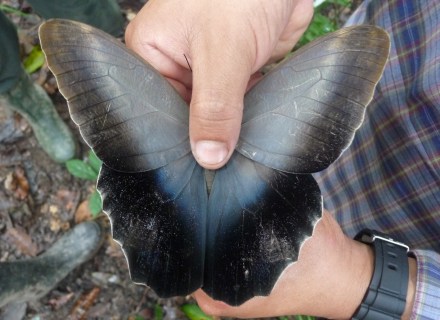
Caligo brasiliensis (Caligo brasiliensis)
Phylum — arthropoda
Class — insecta
Order — lepidoptera
Family — nymphalidae
Genus – caligo
Appearance
The younger caterpillars are yellowish-green, the older ones are brown, with five long outgrowths on the back. There are 8 horns on the head, pointing backwards. The caterpillars are covered with short hairs. They have a short double "tail".
The wingspan of this butterfly is up to 17 cm. The upper side of the wings is purplish-blue. On the underside of the hind wings, there is one large eyespot on each wing.
Habitat
The species can be found in most of South America as various subspecies, including Brazil, Colombia, Venezuela and Ecuador. Its range extends through Trinidad, Honduras, Guatemala and Panama north to Mexico.
Behavior
Caligo brasiliensis is active in the morning and evening hours. The mating dance of the male is very beautiful. In nature, the caterpillars spoil banana plantations.
Diet
The larvae of the nominate subspecies have been recorded on Euterpe edulis, Musa species, and Hedychium coronarium.
Reproduction
For their reproduction you need a terrarium with a size of 70 x 70 x 90 cm at the temperature of 26-28 °C. Females lay eggs in groups of 3-5 eggs on the leaves of the forage plant. Eggs are white and round. The incubation period is 20 days. Caterpillars from the same group hatch at the same time and try to stick together. During the day, they sit on the lower part of the leaf, and at night they feed. The temperature for keeping is 26-28 °C and humidity is 60-80%. It is better not to transplant caterpillars from one plant to another and put them in a terrarium pot with a plant. The caterpillar develops for 30-50 days. The pupae are beige-yellow. The pupa develops for 3 weeks. Adult butterflies live up to 3 months.
In captivity
The mesh terrarium with a size of 50 × 50 × 70 mm is suitable for keeping butterflies. Room temperature is necessary. Daylight time is 12 hours. You can feed the butterflies with an overripe banana, orange, pineapple, mango, or give them a few drops of honey syrup diluted with boiled water in a ratio of 1:10. You can give them a mixture of overripe banana, yogurt and orange juice.
 Russian
Russian
 English
English


















